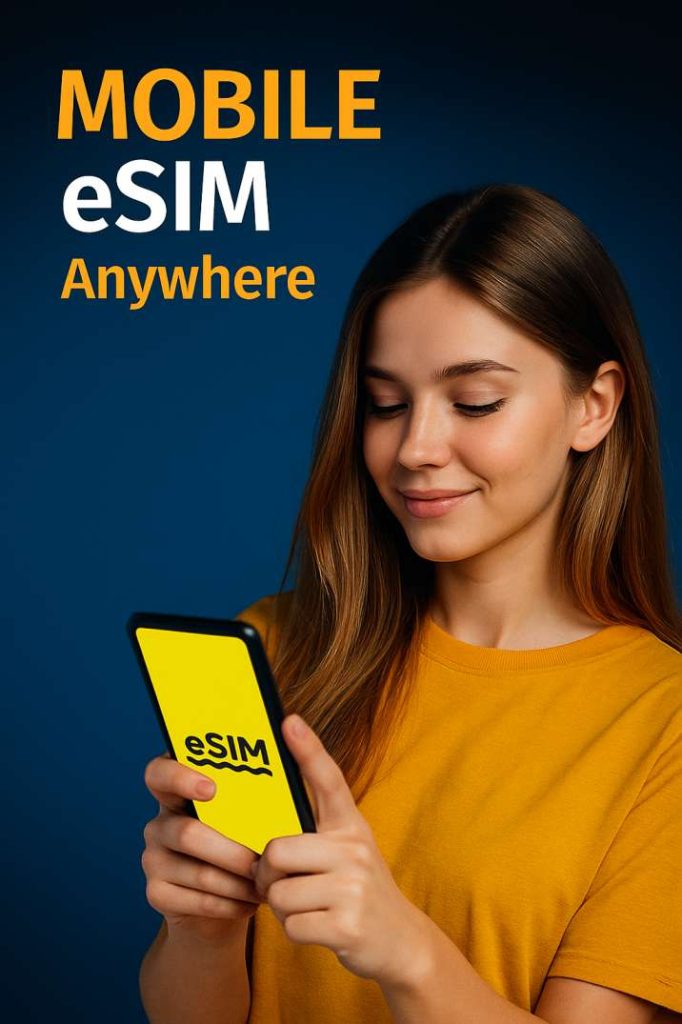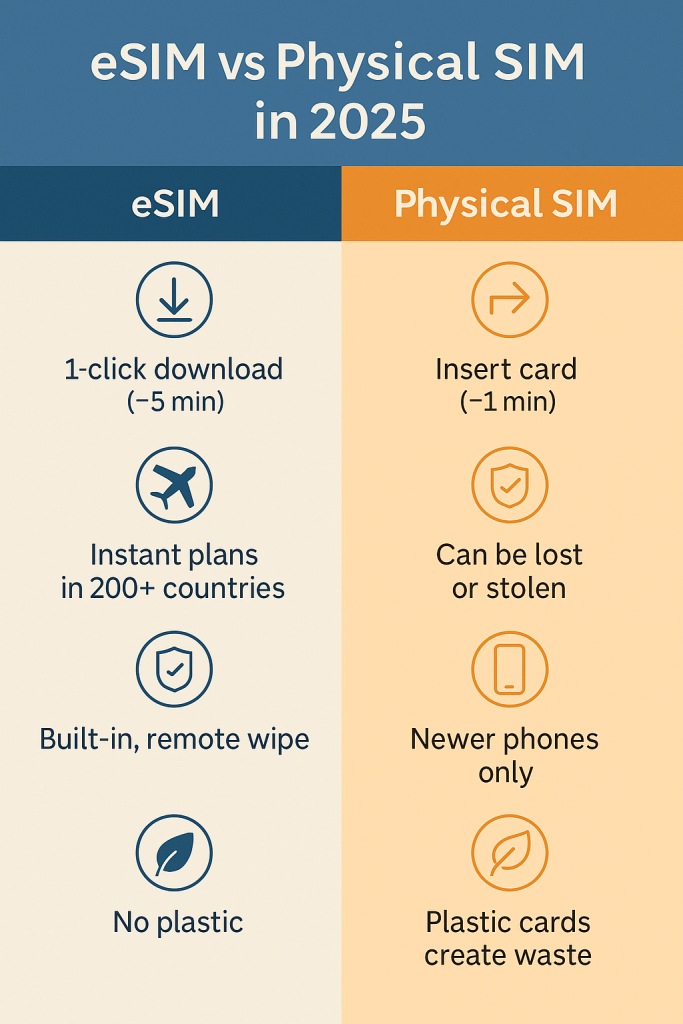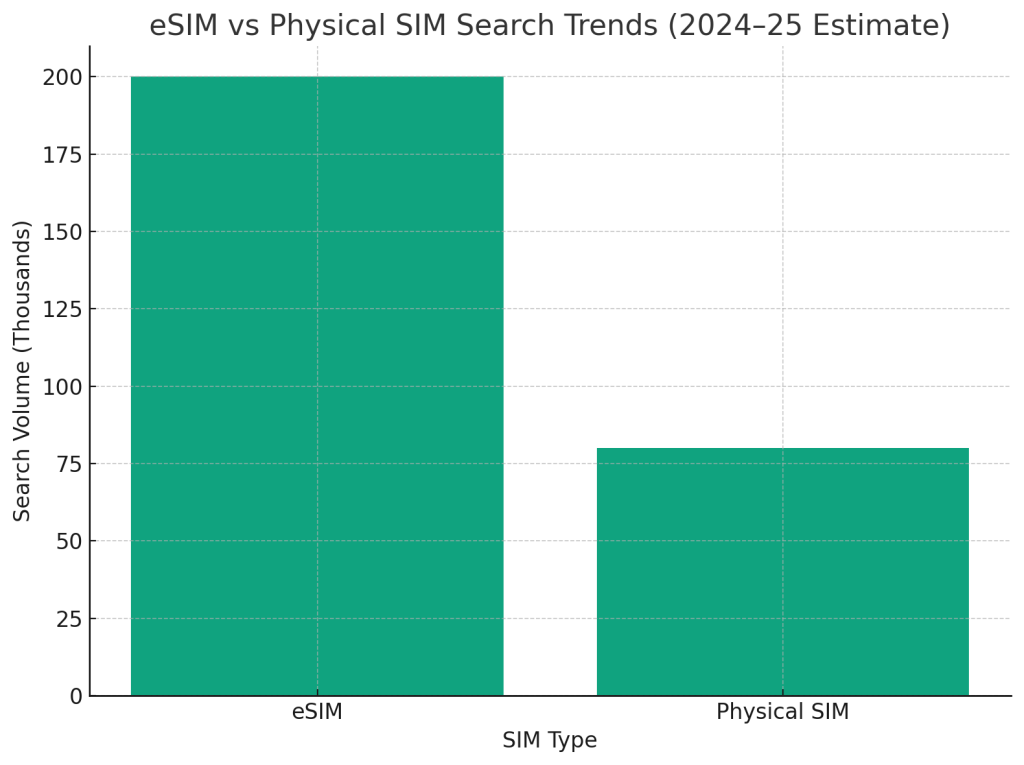
In 2025, staying connected is super important, whether you’re traveling the world or using your phone at home. But which is better: an eSIM or a physical SIM? An eSIM is a digital SIM built into your phone, while a physical SIM is a small plastic card you insert. This guide compares eSIM vs physical SIM to help you pick the best one for 2025. We’ll look at advantages, disadvantages, and use cases, with a chart and info-graphic to make it easy!
What Are eSIMs and Physical SIMs?
- eSIM: A digital SIM inside your phone. You download a plan online to get data, calls, or texts without a card.
- Physical SIM: A plastic card you put in your phone to connect to a network. You swap it to change plans or carriers.
Both get you online, but they work differently. Let’s compare their pros and cons for travel and daily use in 2025!
Pros and Cons: eSIM vs Physical SIM
eSIM Advantages
- Super Easy to Use:
- Switch carriers or plans with a few taps on your phone—no need to visit a store or swap cards.
- Use Case: Download a new plan while sipping coffee at an airport before a trip.
- Great for Travel:
- Get local data plans in 200+ countries instantly, perfect for international trips.
- Use Case: Land in Paris and activate a cheap local plan to navigate or share photos.
- More Secure:
- Built into your phone, so it can’t be lost or stolen. You can wipe it remotely if your phone is lost.
- Use Case: Keep your data safe while exploring busy tourist spots.
- Saves Space:
- No SIM slot needed, so phones can have sleeker designs or extra features.
- Use Case: Enjoy a slim, modern phone with room for better cameras or batteries.
- Eco-Friendly:
- No plastic cards mean less waste, helping the planet.
- Use Case: Feel good about using a digital solution for your trips.
eSIM Disadvantages
- Not All Phones Work:
- Older phones or some budget models don’t support eSIMs yet.
- Challenge: You might need a new phone to use an eSIM.
- Setup Can Be Tricky:
- Some users may find downloading plans confusing without help.
- Challenge: You need a good internet connection to set it up.
Physical SIM Advantages
- Works with All Phones:
- Almost every phone, old or new, uses physical SIMs.
- Use Case: Pop a SIM into an old phone for backup during travel.
- Simple to Understand:
- Easy to buy and insert a SIM card, no tech skills needed.
- Use Case: Get a SIM at a local shop for quick setup.
- Easy to Swap:
- Move your SIM between phones or devices without hassle.
- Use Case: Share a SIM with a friend’s phone for a day trip.
Physical SIM Disadvantages

- Harder to Switch:
- You need to physically swap cards to change carriers or plans.
- Challenge: Finding a new SIM abroad can be a hassle.
- Easy to Lose:
- Small cards can get lost or damaged, leaving you disconnected.
- Challenge: Lose your SIM during travel and you’re stuck.
- Not Eco-Friendly:
- Plastic cards create waste, unlike digital eSIMs.
- Challenge: Extra cards pile up if you travel often.
Infographic: eSIM vs Physical SIM in 2025

Which Is Better for You in 2025?

- Choose eSIM If:
- You travel often and want quick, local data plans.
- You have a newer phone (e.g., iPhone 14, Samsung Galaxy S23, or later).
- You care about security and eco-friendly options.
- Example: A traveler downloading a 5G plan for a trip to Japan without visiting a store.
- Choose Physical SIM If:
- You use an older phone that doesn’t support eSIMs.
- You prefer simple, hands-on setup without apps.
- You swap phones often and need an easy transfer.
- Example: A user with an old phone buying a SIM at a local shop for a weekend trip.
Tips for Using eSIMs or Physical SIMs in 2025
- Check Your Phone: See if your device supports eSIMs on the manufacturer’s website.
- Plan Ahead: Buy eSIM plans online or grab physical SIMs before travel.
- Save Data: Use Wi-Fi for big downloads to stretch your plan.
- Keep Backup: Carry a physical SIM as a backup if your eSIM fails.
- Get Support: Use 24/7 support from eSIM providers like Nomadoverse, Yesim or Airalo for help.
Opportunities for Travel Businesses
- Sell eSIMs: Bundle eSIM plans with travel gear like bags or chargers.
- Boost SEO: Use keywords like “eSIM vs physical SIM 2025” or “best travel SIM 2025.”
- Promote Plans: Market eSIMs for travelers needing fast data.
- Travel Packages: Offer eSIMs with tour deals for easy connectivity.
Frequently Asked Questions
What’s the Difference Between eSIM and Physical SIM?
An eSIM is digital and built into your phone; a physical SIM is a plastic card you insert.
Why Choose an eSIM for Travel?
It’s easy to get local data plans in 200+ countries without swapping cards.
Are Physical SIMs Still Good?
Yes, for older phones or simple setups, but they’re less flexible.
Which Is More Secure?
eSIMs are safer because they’re built-in and can be wiped remotely.
Pick the Best SIM for Your 2025 Adventures
In 2025, eSIMs are the top choice for travelers and tech-savvy users, offering easy setup, global plans, and better security. Physical SIMs are great for older phones or simple needs but can be less convenient. Check your phone and choose what fits your lifestyle! Buy eSIMs from providers like Nomadoverse, esim or Airalo and plan trips with Expedia or Booking.com. Stay connected and enjoy your 2025 adventures!
